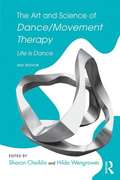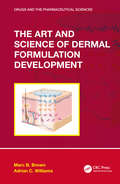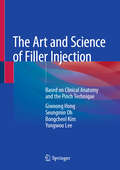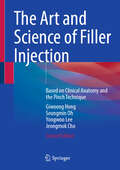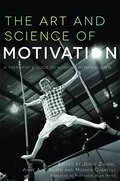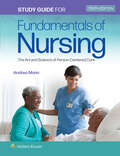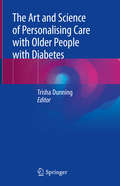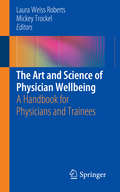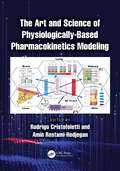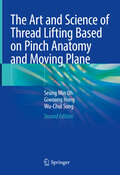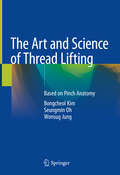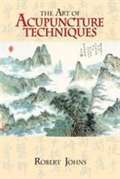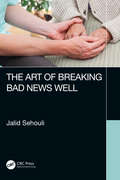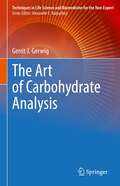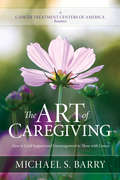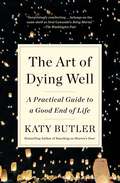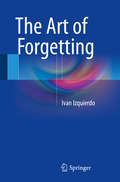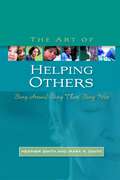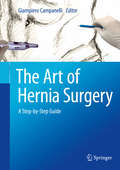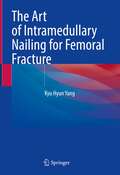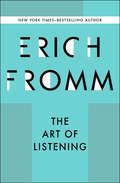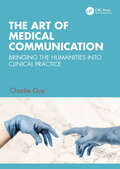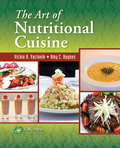- Table View
- List View
The Art and Science of Dance/Movement Therapy Life is Dance: Life is Dance (2nd Edition)
by Hilda Wengrower Sharon ChaiklinThis second edition of The Art and Science of Dance/Movement Therapy offers a broad understanding of dance/movement therapy as well as an in-depth exploration of how and where it can be used to produce change. The chapters that make up this innovative volume go beyond the basics to offer a unique collection of theoretical perspectives paired with case studies designed to emphasize techniques that can be applied in a variety of settings. In addition to boasting thoroughly expanded versions of all previously published content, this timely reference includes an all new chapter on DMT interventions in palliative care and added references throughout to reflect to the most current knowledge.
The Art and Science of Dermal Formulation Development (Drugs and the Pharmaceutical Sciences)
by Marc B. Brown Adrian C. WilliamsThe Art and Science of Dermal Formulation Development is a comprehensive guide to the theory and practice of transdermal and topical formulation development, covering preclinical studies, evaluation, and regulatory approval. It enables the reader to understand the opportunities and challenges in developing products and how risks can be mitigated. Over the last 25 years, expertise in this area has declined whilst drug delivery systems for other administration routes have developed significantly. The advantages offered by transdermal and topical drug delivery remain compelling for sectors including the pharmaceutical industry, personal care, and cosmetics. This text addresses the dearth of expertise and discusses how skin can be a route of delivery and the processes in formulation development, but how such an application is very different to that used for oral, IV, and other administration routes.
The Art and Science of Filler Injection: Based on Clinical Anatomy and the Pinch Technique
by Bongcheol Kim Seungmin Oh Giwoong Hong Yongwoo LeeThis highly illustrated book describes how to perform dermal filler procedures in a way that simultaneously takes into account esthetic and safety aspects in order to achieve optimal outcomes in individual patients. After discussion of filler materials and design considerations, the relevant basic and clinical anatomy is described, drawing on cadaveric examinations and imaging in living subjects. Step-by-step instruction is then provided on how to identify a safe injection plane and on injection using the pinch technique. The coverage includes guidance on injection procedures specific to different sites. A thorough and systemic description of potential side effects of filler injection, and the management of complications is also presented. The Art and Science of Filler Injection equips the reader with a sound knowledge of all aspects relevant to the achievement of pleasing esthetic results without side effects and will be of value for practitioners at all levels of experience.
The Art and Science of Filler Injection: Based on Clinical Anatomy and the Pinch Technique
by Seungmin Oh Giwoong Hong Yongwoo Lee Jeongmok ChoThis highly illustrated book describes how to perform dermal filler procedures in a way that simultaneously takes into account esthetic and safety aspects in order to achieve optimal outcomes in individual patients. After discussion of filler materials and design considerations, the relevant basic and clinical anatomy is described, drawing on cadaveric examinations and imaging in living subjects. Step-by-step instruction is then provided on how to identify a safe injection plane and on injection using the pinch technique. The coverage includes guidance on injection procedures specific to different sites. A thorough and systemic description of potential side effects of filler injection, and the management of complications is also presented. The Art and Science of Filler Injection equips the reader with a sound knowledge of all aspects relevant to the achievement of pleasing esthetic results without side effects and will be of value for practitioners at all levels of experience. By updating the latest knowledge on anatomy and mechanics for safe filler procedure, it makes it possible for readers to perform the best filler procedure with confidence.
The Art and Science of Motivation
by Jenny Ziviani Anne A. Poulsen Monica CuskellyPlacing motivation at the heart of all encounters and therapeutic activities, this book presents a groundbreaking, evidence-based model for working with children, including those with physical disabilities, learning disabilities and emotional and behavioural difficulties. Drawing on Self-Determination Theory (SDT), the authors describe this innovative paradigm - the model of Synthesis of Child, Occupational Performance and Environment - in Time (SCOPE-IT) - and explain how it can be used to sustain the child's motivation and active involvement in the therapeutic process. They suggest ways of using language and of structuring and working with the environment to maximise engagement and autonomy and achieve the best possible treatment outcomes. The challenges professionals may face when working with children are also clearly addressed, and engaging case studies and photographs place the key theoretical concepts in a richly human and personal context. Combining accessible theory with a wealth of tools and strategies for practice, this book is essential reading for all those working therapeutically with children, including occupational therapists, speech and language therapists, psychologists and psychotherapists.
The Art and Science of Person-Centered Care: The Art and Science of Person-Centered Care
by Carol R. TaylorStudy Guide to Accompany Fundamentals of Nursing: The Art and Science of Person-Centered Nursing Care, Tenth Edition Created in conjunction with Fundamentals of Nursing: The Art and Science of Patient-Centered Care, Tenth Edition, this valuable Study Guide helps students review and apply important concepts to prepare for exams—and their nursing careers! Assessing Your Understanding provides a variety of exercises such as matching and fill-in-the-blank questions to help students retain key information. Applying Your Knowledge challenges students with critical thinking questions, reflective practice exercises to help cultivate QSEN competencies, and patient care studies. Practicing for NCLEX provides multiple-choice and alternate-format questions to help students review content and become familiar with the NCLEX format.
The Art and Science of Personalising Care with Older People with Diabetes
by Trisha DunningThis unique book is intended for all health professionals caring for older people with diabetes such as specialist and general nurses, doctors, primary care practioners and dieteticians. Although there is an increasing body of work about personalised care, no publications were identified that encompass the focus and scope of the proposed book. The global population is ageing and increasing age is a key risk factor for diabetes. Older people with diabetes are often vulnerable, have complex care needs and often have cognitive changes, which makes personalising care challenging for health professionals. Thus, this is an internationally relevant book filling a gap in the current literature. This is a practical and updated book that will use an engaging and easy to read narrative style. It challenges readers to reflect in and on their practice. It encompasses people with diabetes’ and authors’ stories, which are known to have a special interest to readers, make it easier to apply the information to practice, enhance learning, and hence the relevance and value of the book.It is relevant to advocacy organisations as well as managers and service planners. Researchers and scientists may find relevant information on grant and ethics applications, research protocols, plain language statements for potential participants and operationalising research protocols.
The Art and Science of Physician Wellbeing: A Handbook for Physicians and Trainees
by Laura Weiss Roberts Mickey TrockelThis thoughtful and timely book offers physicians and trainees a wide range of insights and strategies to help ensure not only a healthy lifestyle and sense of wellbeing but the best possible career in medicine as well. With evidence and evidence-informed practices provided by experts, this title affirms the culture of medicine while embracing the fundamental, enduring sense of physicians’ calling and affirming the importance of physicians as individuals whose health and wellbeing has intrinsic value and value to others. Organized in three parts, the first part focuses on the nature of the health professions and on advancing a culture of wellbeing in medicine. The second part focuses on threats to physician wellbeing, including mistreatment during training and burnout, to name just a few. The third part outlines approaches to strengthening physician resilience, such as the sustenance drawn from healthy relationships, mindfulness approaches, and optimal approaches to exercise, nutrition and sleep. The Handbook of Personal Health and Wellbeing for Physicians and Trainees is an invaluable, handy resource for physicians and trainees. Physician assistants, nurse practitioners, clinical psychologists, and social workers will also find the work of great interest.
The Art and Science of Physiologically-Based Pharmacokinetics Modeling
by Rodrigo CristofolettiThis state-of-the-art text describes the science behind the system and drug-dependent components of PBPK models, its applications in translational and regulatory science, e.g., guiding drug discovery and development, and supporting precision medicine initiatives. To incorporate state-of-the-art knowledge, each chapter is written by leaders in the field and illustrated by clear case studies. Connecting basic and applied science, this book explores the potential of PBPK modeling for improving therapeutics and is designed for a wide audience encompassing graduate students as well as biopharmaceutics scientists and clinical pharmacologists.Features:1. Provides a basic understanding of the physiologically-based pharmacokinetic modeling and its applications2. Assists the reader in understanding product performance to allow for rapid product development and establish bioequivalence3. Well-constructed content and added value of real examples4. Illustrates how using available resources via modeling and simulation leads to a reduction in the costs related to drug development, which directly affects the costs to patients
The Art and Science of Thread Lifting Based on Pinch Anatomy and Moving Plane
by Giwoong Hong Seung Min Oh Wu-Chul SongThis book is a thorough guide on how to perform safe and effective thread-lifting procedures as a less invasive approach to rejuvenation of the face. The opening chapters explain the importance of the fixation technique, describe the facial and the pinch anatomy, and discuss the characteristics of absorbable threads. Clear descriptions are then offered of the basic technique employed for thread lifting, as well as techniques applicable for each thread type and techniques specific to each anatomic area. Understanding is aided by the inclusion of an abundance of illustrations depicting anatomy and technique. Potential complications and their management are systematically explained, and a new approach to outcome evaluation is also presented. The Art and Science of Thread Lifting will help plastic surgeons and dermatologists at all levels of experience to achieve the best possible outcomes in individual patients. The new edition updates of new studies related to thread lifting and techniques. Readers will be able to easily access new theories and developed contents in the field of thread lifting, learn safer and more effective thread lifting procedures.
The Art and Science of Thread Lifting: Based on Pinch Anatomy
by Bongcheol Kim Seungmin Oh Wonsug JungThis book is a thorough guide on how to perform safe and effective thread-lifting procedures as a less invasive approach to rejuvenation of the face. The opening chapters explain the importance of the fixation technique, describe the facial and the pinch anatomy, and discuss the characteristics of absorbable threads. Clear descriptions are then offered of the basic technique employed for thread lifting, as well as techniques applicable for each thread type and techniques specific to each anatomic area. Understanding is aided by the inclusion of an abundance of illustrations depicting anatomy and technique. Potential complications and their management are systematically explained, and a new approach to outcome evaluation is also presented. The Art and Science of Thread Lifting will help plastic surgeons and dermatologists at all levels of experience to achieve the best possible outcomes in individual patients.
The Art of Acupuncture Techniques
by Robert JohnsAcupuncture patients who want the nitty-gritty of such needling techniques as depth, placement, and needle type should read The Art of Acupuncture Techniques. It's unique historical perspective preserves theoretical concepts that haven't been taught in China since the Cultural Revolution. If you really want to know what's going on during treatment, whether you're seeking relief from a skin condition, angina, or infertility, it's right on target.
The Art of Breaking Bad News Well
by Jalid SehouliAs Head of Oncological Surgery and the Gynecology Clinic at Berlin’s Charité Comprehensive Cancer Center, Jalid Sehouli is one of the world’s leading cancer specialists. Every day, he experiences situations in which conversations take on a life-or-death significance. Delivering bad news is one of the most difficult tasks we face in life, especially for professionals such as doctors, police, or crisis intervention personnel, yet it is rarely touched on during training. Over the course of their career, a doctor will hold conversations with around 200,000 patients and their relatives that invariably involve delivering good or bad news. Either way, existential questions will arise, and the way the news is delivered is vital: recent studies show that it has a significant impact on patients’ quality of life and the way they experience treatment. Mixing his wide-ranging professional experience with personal stories, Sehouli describes the emotions and perspectives of those who have to give and receive bad news from a broad perspective. His book can be helpful for anyone who has to deliver bad news—managers, friends, or parents.
The Art of Carbohydrate Analysis (Techniques in Life Science and Biomedicine for the Non-Expert)
by Gerrit J. GerwigThe growing importance of glycobiology and carbohydrate chemistry in modern biotechnology and the pharmaceutical industry makes accurate carbohydrate analysis indispensable. This book provides the principles and protocols of various fundamental carbohydrate analysis methods. Choice of method is entirely dependent upon the type of material being investigated (biological samples, food products, etc.), and the level of structural detail required, i.e. sugar content, compositional analysis, linkages between the sugar components, or the total chemical structure of a given molecule. Full structural characterization of carbohydrate chains requires significant time, resources, and skill in several methods of analysis; no single technique can address all glycan analysis needs.This book summarizes several existing analytical techniques (both chemical and physical) in an introductory volume designed for the non-expert researcher or novice scientist. While background in carbohydrate chemistry is assumed, all information necessary to understanding the described techniques is addressed in the text.
The Art of Caregiving
by Michael S. BarryWritten to encourage the caregiver, The Art of Caregiving will be a candle of joyful hope to the one whose life has taken on unique new challenges when a loved one faces cancer.Cancer treatment is often a nighttime journey through a wilderness, during which patients and their caregivers are confronted with worry and fear; a journey where the slightest flicker of hope means more than words can express.Michael S. Barry shows how, with God's help, you can be the light of hope for those who bear the burden of illness.
The Art of Dying Well: A Practical Guide to a Good End of Life
by Katy ButlerThis &“comforting…thoughtful&” (The Washington Post) guide to maintaining a high quality of life—from resilient old age to the first inklings of a serious illness to the final breath—by the New York Times bestselling author of Knocking on Heaven&’s Door is a &“roadmap to the end that combines medical, practical, and spiritual guidance&” (The Boston Globe).&“A common sense path to define what a &‘good&’ death looks like&” (USA TODAY), The Art of Dying Well is about living as well as possible for as long as possible and adapting successfully to change. Packed with extraordinarily helpful insights and inspiring true stories, award-winning journalist Katy Butler shows how to thrive in later life (even when coping with a chronic medical condition), how to get the best from our health system, and how to make your own &“good death&” more likely. Butler explains how to successfully age in place, why to pick a younger doctor and how to have an honest conversation with them, when not to call 911, and how to make your death a sacred rite of passage rather than a medical event. This handbook of preparations—practical, communal, physical, and spiritual—will help you make the most of your remaining time, be it decades, years, or months. Based on Butler&’s experience caring for aging parents, and hundreds of interviews with people who have successfully navigated our fragmented health system and helped their loved ones have good deaths, The Art of Dying Well also draws on the expertise of national leaders in family medicine, palliative care, geriatrics, oncology, and hospice. This &“empowering guide clearly outlines the steps necessary to prepare for a beautiful death without fear&” (Shelf Awareness).
The Art of Forgetting
by Ivan IzquierdoHow do we forget? Why do we need to forget? This book intends to answer to these and other questions. It aims to demonstrate that each one is who it is due to their own memories. Thus, distinguish between the information we should keep from those we should forget is an difficult art. In this book, the author discusses about the different types of memory, the main types of forgetting (avoidance, extinction and repression), their brain areas and their mechanisms. In this sense, the art of forgetting, or the art of do not saturate our memory mechanisms, is something innate, that benefits us anonymously, keeping us from sinking amidst our own memories. The essays that compose this book go through several aspects, since individuals to societies' memory. By the end of the book, the reader will be able to understand that we forget to be able to think, to live and to survive.
The Art of Helping Others: Being Around, Being There, Being Wise
by Heather Smith Mark K. SmithWhen searching for someone to help them reflect upon and improve their lives, people tend to be drawn towards those who are compassionate, committed and wise. This book is aimed at those who recognise these qualities in themselves and wish to develop their capacity to engage with and help others. The authors argue for ways of approaching helping and counselling that are rooted in care and commitment, drawing upon the experiences and practice wisdom of youth workers, housing support and hostel workers, the clergy and those working in a religious setting, educators and settlement and community workers. They explore the key characteristics of those who counsel and teach and examine aspects of the helping process, focusing on living life well, knowing and being oneself, relating to others and working to make change possible. This book will be essential reading for students on professional training programmes in youth work, community education, ministry, social care and counselling.
The Art of Hernia Surgery: A Step-by-step Guide
by Giampiero CampanelliThis book is a comprehensive guide to the surgical repair of inguinal and abdominal wall hernias that not only describes all potential approaches, but also places them in the context of the anatomy of the region, the pathology, and the advances in scientific knowledge over the past decade. It documents in detail the individual techniques applicable in each region (inguinal, femoral, and ventral), highlighting tips and tricks and focusing on indications, potential complications, and outcomes. In addition, it presents cases of incisional hernia and examines less frequent and rare cases and complex situations. Written for surgeons from around the globe, it includes procedures used in wealthy, developed countries and those without mesh more commonly employed in developing countries. With a format designed to facilitate use in daily practice, it is invaluable for residents seeking step-by-step guidance on procedures ranging from repair of simple inguinal hernias to complex reconstruction; for general surgeons who frequently perform hernia repairs; and for hernia specialists aiming to achieve optimal results. It also appeals to researchers with an interest in the scientific background to hernia surgery.
The Art of Intramedullary Nailing for Femoral Fracture
by Kyu Hyun YangThis book offers precise points in intramedullary nailing for the treatment of the femoral fracture. The author's aim is to explain how to find a correct entry point, especially in the case of subtrochanteric fracture with excessive external rotation of the proximal fragment, method of reduction in a severely comminuted fracture which is challenging in the restoration of rotational alignment as well as angulation, and mode of interlocking. This book is based on the author’s personal experiences of 30 years in trauma, who dedicates himself to developing intramedullary nailing for femoral shaft fracture. It also covers cephalomedullary nailing for reverse obliquity trochanteric fracture because the incidence of hip fractures increases due to prolonged life expectancy. This book will be an ideal resource with many fluoroscopic and radiographic pictures to descript the real situations that the surgeons encounter in the operating room and techniques to solve those problems.
The Art of Keeping Secrets: A Novel
by Rachael JohnsSome Secrets Weren't Meant to Be Kept... They started out as the "misfit moms"-the trio of less-than-conventional parents at their sons' tony private school. They've shared everything. Or so they thought. Now, on a once-in-a-lifetime trip to New York City, they'll sightsee, they'll shop, they'll catch a few Broadway shows. They'll tell all... After seventeen years as a single parent, Neve will reveal a past sin that could destroy her relationship with her son. Emma will uncover the roots of her exhaustion and divulge the inappropriate feelings she has for her boss. And Flick-who knows a little about crafting a flawless exterior-will share the shocking truth that lies beneath the veneer of her perfect marriage. When the tight hold they've each kept on their secrets for years begins to slip, they must face the truth. Even if the truth will forever alter the course of their friendship and their lives.
The Art of Listening
by Erich FrommThe renowned social psychologist and New York Times–bestselling author shares his insights on the process of psychotherapy, drawing on his own experience. Over the course of a distinguished career, Erich Fromm built a reputation as a talented speaker and gifted psychoanalyst—the first specialization of this polymath. The Art of Listening is a transcription of a seminar Fromm gave in 1974 to American students in Switzerland. It provides insight into Fromm&’s therapy techniques as well as his thoughts and mindset while working. In this intimate look at his profession, Fromm dismantles psychoanalysis and then reassembles it in a clear and engaging fashion. This ebook features an illustrated biography of Erich Fromm including rare images and never-before-seen documents from the author&’s estate.
The Art of Medical Communication: Bringing the Humanities into Clinical Practice
by Charlie GuyThe field of medical humanities is growing rapidly and offers many valuable insights for medical education generally and for enhancing and improving communication specifically. Through practical and thought-provoking examples, this innovative new text demonstrates how engaging with the arts and humanities can benefit the work of doctors and make them better, more effective practitioners with a focus on achieving this through better communication and by stimulating self-reflection. Key features: Utilises modern and familiar examples, including case studies, to illustrate and explore language and communication skill deployment in a variety of given scenarios Reflects the increasing use of online consultation and the associated importance of ensuring effective communication in virtual settings Describes several models for reflective practice Supported by a selection of eResources to enhance reader experience and understanding; visit www.routledge.com/9781032272726 This new book is written specifically for medical students, junior doctors and medical educators looking to develop or teach communication skills. It will instil and support the background understanding of the role, need and ongoing requirement for humanities engagement in self-development and reflection to enhance and improve the experience of both the practitioner and the patient.
The Art of Medicine in Early China
by Miranda BrownIn this book, Miranda Brown investigates the myths that acupuncturists and herbalists have told about the birth of the healing arts. Moving from the Han (206 BC–AD 220) and Song (960–1279) dynasties to the twentieth century, Brown traces the rich history of Chinese medical historiography and the gradual emergence of the archive of medical tradition. She exposes the historical circumstances that shaped the current image of medical progenitors: the ancient bibliographers, medieval editors, and modern reformers and defenders of Chinese medicine who contributed to the contemporary shape of the archive. Brown demonstrates how ancient and medieval ways of knowing live on in popular narratives of medical history, both in modern Asia and in the West. She also reveals the surprising and often unacknowledged debt that contemporary scholars owe to their pre-modern forebears for the categories, frameworks, and analytic tools with which to study the distant past.
The Art of Nutritional Cuisine
by Vickie A. Vaclavik Amy HaynesNow more than ever, culinary professionals are expected to provide cuisine that satisfies the diverse nutritional needs of a vast population of consumers. While the public has become increasingly health conscious, chefs can serve well-presented, great-tasting, and nutritious foods that at the same time support a healthy lifestyle. The Art of Nutrit
